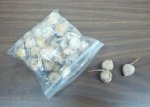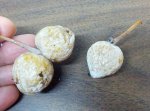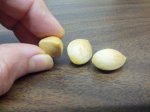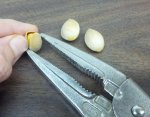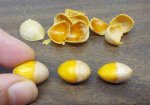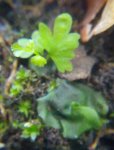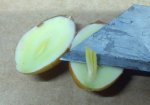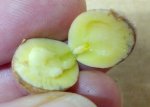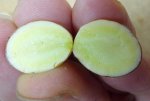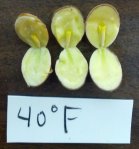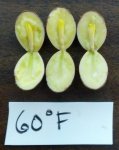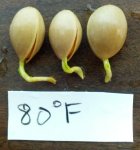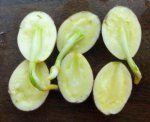I had never grown ginkgo (Ginkgo biloba) seeds before, so when I noticed them under a tree in late November, I collected some to investigate.
I had a ziplock bag with me, and filled it up with the “fruits”. Botanically, these are not fruits at all, but that’s another story. It’s well known that these smell bad, at least when freshly fallen. The odor is described as rancid butter, or dog shit. However the autumn weather had been torrential rain, and the scent was all leached away.
It was about a month before I got around to the seeds. Meanwhile, I left the bag outdoor so the “fruits” would stay moist in the wet autumn weather. On December 31, 2015, I started my experiments.
The “berries” were single or in pairs, on stalks.
When I peeled off the fleshy covering, inside were the seeds.
I gently cracked them open.
Inside were the kernels.
I knew that, botanically, ginkgo seeds are not like angiosperm seeds, where the embryo plant grows to a certain stage, and then various inhibitions come into play to keep it dormant. The ginkgo life cycle is more like a fern.
The brown dots on fern leaves shed microscopic dust-like spores. These drift on the wind. If a spore lands in the right conditions of moist soil, it grows into a prothallus. Prothallii are quite common, once you learn to spot them. Here is a picture of some that appeared in one of my potted plants.
The dark green membranous thing in the lower right is the prothallus. It looks like a bit of seaweed washed up, that hasn’t dried out yet. It grew from a drifting spore, by the grace of drip irrigation watering that kept the soil continuously moist. The prothallii of most kinds of ferns can only develop in continually moist sites (this is where to look for them), though some cliff ferns have prothallii that can survive drying out.
With good luck, the prothallus grows to full size, which is only about a quarter inch across. When mature, it develops male and female gametes on its underside. When there is enough water, the male ones swim to the female ones, presumably sometimes to a different prothallus for genetic mixing. The fertilized zygote develops into a lump of cells, nourished at first by the prothallus. When this embryo plant gets big enough, it puts its first root down, its first leaf up, and grows into what most people recognize as a fern. The lighter green leaves towards the top of the photo are such a baby fern. It is growing out of a different prothallus than the lower right one, but it is behind the leaves and hard to see.
Other spore plants, like horsetails, also produce these gametophytes. “Gameto-phyte”, because it forms the gametes. The horsetail gametophytes I have seen are also green, but fleshier. Still other spore plants, like club mosses, supposedly produce lumpy gametophytes underground, but I have never seen them. The general plan is, the spore grows into a gametophyte, which only does two things: Produces gametes, and then nurtures the main plant till it gets on its own.
It doesn’t seem fair. The fern gametophyte has to eke out a living as a miserable prothallus, harvesting enough sunlight to grow and start the next generation, while desperately living on the edge of death by desiccation. But the main fern plant is big and robust, with roots and tall fronds, and all. Why couldn’t it help out the next generation of gametophytes with some of its bounty?
This is evidently what ginkgoes have done. Instead of casting spores to the wind, the ginkgo holds them on little stalks. As a spore develops into a gametophyte, the tree feeds and shelters it. Instead of having to live free or die, the ginkgo gametophyte has a pampered life. How the gametes get to it from a different gametophyte is another story, but the hint is: Pollen.
So, I looked at these ginkgo kernels, and I thought: When I want to grow ferns, I get the spores, and set up moist mellow conditions, and by and by they to grow into prothallii. Then I just wait. In their own sweet time, they get around to the gamete thing, and then start with the lump of cells. Once the first fern leaf appears, I’m home free.
So, here with this ginkgo seed, it’s all been done for me. No fragile prothallus to fuss over. This gametophyte doesn’t have to be green because it doesn’t need photosynthesis. It was well provisioned by the tree. So, instead of thin and membranous, it’s fleshy and packed with stored food.
I sliced some of the ginkgo kernels open, and there were the developing plant embryos. This was exactly analogous to the lump-of-cells stage of a fern plant on its prothallus.
The ginkgo plantlets were different sizes. Some were about half the length of the seed, but some were as short as a quarter the seed length.
Some gametophytes had no baby plant at all. I guess sometimes the male ginkgo is shooting blanks.
So, I thought, maybe it’s the same as growing ferns. You just set them up and let them take their own sweet time. They don’t need light in this case, but they probably want to be moist.
I divided my ginkgo seeds into three groups. I put them in ziplock sandwich bags with damp sawdust. Probably sand would have worked as well, or moist leaves, or even torn-up wet strips of paper.
One bag I kept about 40 degrees. This was outdoors in an unheated garage. It might have occasionally got frosty, and sometimes as warm as 50 degrees.
One bag I kept about 60 degrees. This was indoors, on the floor of the basement.
One bag I kept about 80 degrees. This was in a plant growing room with warm lights.
On February 3, 2016, I checked on them. This was after about a month, 34 days. All three had been going for the same length of time.
I picked three seeds at random out of the 40 degree bag. The embryos had grown some, but not much. They averaged about half the length of the seed.
I picked three seeds at random from the 60 degree bag. Here, the embryos were definitely bigger, about three fourths the length of the seed. If you can see, in the middle one, the root is starting to push out of the gametophyte.
When I came to the 80 degree bag, I did not pull them at random. I grabbed the first three that were obviously clambering to get out.
It looks like ginkgoes have something like hypogeal germination. That is, the seed does not get pulled up above ground. The embryo elongates to push the leaf bud outside the seed, along with the root, and then a shoot grows up from that. The upper ends of the “cotyledons”, or whatever they are, stay inside the seed, to continue feeding from the gametophyte.
So, it appears to me that ginkgoes do not have true seed dormancy, as angiosperms do. To avoid coming up too early, in the midst of winter, the ginkgo embryo simply develops very slowly, as long as things stay cold. Instead of counting chill hours, they just pace themselves. When spring comes, they speed up. The warmer it gets, the faster they grow.
If you want to grow ginkgo seeds, just keep them warm, and they’ll sprout. They absolutely do not need to be frozen. Deep freezing would probably kill them. Drying out would probably kill them too. After all, they are just gametophytes.

